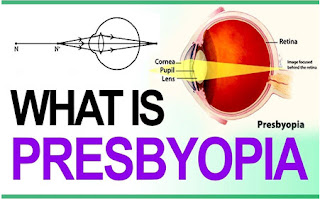The cause of presbyopia is the normal loss of near focusing ability that occurs with age. As people age, the lens becomes harder and less elastic, making it more difficult for the eye to focus on close objects, or less able to focus when you view something close up, or having trouble seeing small print, including text messages on their phone.
Though presbyopia is a normal change in our eyes as we age, it often is a significant and emotional event because it’s a sign of aging that’s impossible to ignore and difficult to hide.
When you become presbyopic, the presbyopia symptoms and signs are you either have to hold your smartphone and other objects and reading material (books, magazines, menus, labels, etc.) farther from your eyes to see them more clearly. Unfortunately, when you move things farther from your eyes they get smaller in size, so this is only a temporary and partially successful solution to presbyopia.
Also, even if you can still see pretty well up close, presbyopia can cause headaches, eye strain and visual fatigue that makes reading and other near vision tasks less comfortable and more tiring.
Because the human lens continues to change as you grow older, your presbyopic prescription will need to be increased over time as well. You can expect your eye specialist to prescribe a stronger presbyopia correction in Singapore for near work as you need it.
Although presbyopia cannot be reversed, it is easy to correct. The simplest way is to wear reading glasses. But if you do not want to wear eyeglasses or contact lenses for presbyopia, your eye specialist can recommend you a number of surgical options to treat presbyopia as well.
1) Eyeglasses. Reading glasses are often sufficient to address your presbyopia if you didn’t require corrective lenses to see prior to the onset of presbyopia. They also might work well if you wear contacts and have recently begun to experience the effects of presbyopia. If you already wear glasses to correct your nearsightedness, farsightedness or astigmatism, you may choose to wear glasses with multifocal lenses. There are three types: progressives, bifocals and trifocals.
2) Contact Lenses. If you have used contact lenses in the past, you may prefer to stick with contacts to treat your presbyopia. In addition to multifocal contacts, the eye doctor may also recommend another option which is monovision with contacts. This involves wearing one contact geared toward distance vision and the other for near vision.
3) Eye surgery. Your eye specialist can perform procedures such as
LASIK and
cataract surgery in Singapore to treat presbyopia as well. These procedures allow you to free yourself of contacts and lessen or eliminate your dependence on glasses. One presbyopia correction in Singapore that’s gaining popularity is the implantation of a corneal inlay. Typically implanted in the cornea of the eye that’s not your
dominant eye, a corneal inlay increases depth of focus of the treated eye and reduces the need for reading glasses without significantly affecting the quality of your distance vision.
Is presbyopia correction a risky operation?
Presbyopia is an age-related condition of the eye in which the eye slowly loses the ability to focus quickly on objects that are close. It is a natural disorder that affects everyone, even those who have had no prior problems, typically occurring around the age of 40. Eye specialist believes that presbyopia is caused by changes to the lens inside the eyes.
Presbyopia is an age-related condition of the eye in which the eye slowly loses the ability to focus quickly on objects that are close. It is a natural disorder that affects everyone, even those who have had no prior problems, typically occurring around the age of 40. Eye specialist believes that presbyopia is caused by changes to the lens inside the eyes.
When young, the lens of the eyes is usually flexible, relatively elastic and the muscles surrounding it would easily reshape and adjust to accommodate both close and distant images. However, with age the lens and the muscles lose their flexibility and elasticity, becoming more stiff and rigid. Eye doctor believes that this would prevent the lens from changing its shape as quickly as it could, constricting the eye’s ability to focus light directly onto your retina.
The first few signs of presbyopia are the gradual deterioration in the ability to read, having difficulty in reading small print or having eyestrain as well as headaches after reading or doing
work up close. Patients would usually need to squint or adjust their reading materials to the ‘appropriate’ distance as well as require brighter light to read or do work up close. Patients with presbyopia would also easily feel fatigued from doing all the tasks mentioned above and would have a problem seeing or focusing on objects that are up close. Today, there are many simple yet highly successful ways to correct refractive errors and conditions with little to no risk involved at all.
Before any
presbyopia correction can be done, an eye specialist would first assess patients to determine if they are suffering from cataracts. If they do, patients are presented with a choice between multi-focal lens technology or mono-focal lens technology for lens implant surgery.
These implants would be implanted during cataract surgery, removing all refractive errors including the likes of myopia, astigmatism, and presbyopia to achieve the spectacle-free vision. While it is implanted in the eye, multi-focal lens implants work similarly to wearing ‘progressive’ spectacles which allow distance, intermediate, and near focus.
The brain will neuro-adapt to the multi-focal visual system postoperatively and will automatically select the eye to focus at whatever is the required distance. On the other hand, a mono-focal lens implant sets one eye for near vision, while the other mono-focal lens implant sets the other eye to see the distance.
The process of neuro-adaptation for mono-vision usually takes slightly longer, a week or two for the brain to adjust and begin to use the eyes naturally in a mono-vision manner. According to the eye doctor, patients will never have to worry about spectacles and cataracts ever again as the power carried in the implanted lens are stable for the rest of the patient’s life and cataracts can never return after it is removed. Both procedures take 15 minutes and are performed under local anesthesia.
Younger patients with presbyopia but no cataract should be able to opt for LASIK as a presbyopia correction procedure. LASIK uses a laser to correct the shape of the lens, treating any refractive errors and restoring perfect vision. It corrects one eye’s focus for far vision and corrects the other eye’s focus for near vision. The brain would merge these two images, enabling the patient to see relatively well at all distances. While it is a simple 10-minute pain-free procedure, LASIK mono-vis.
 Tasselline | Latest Articles By Singaporeans, for Singaporeans Article Site for Singaporeans
Tasselline | Latest Articles By Singaporeans, for Singaporeans Article Site for Singaporeans




